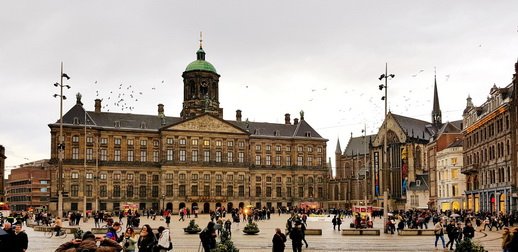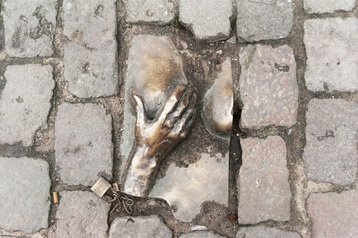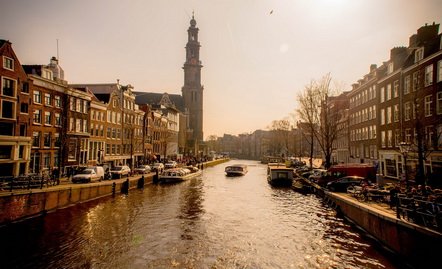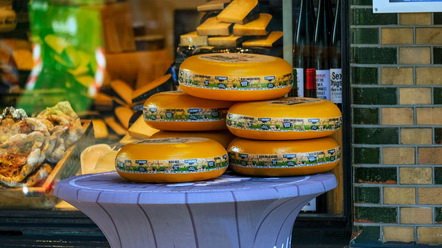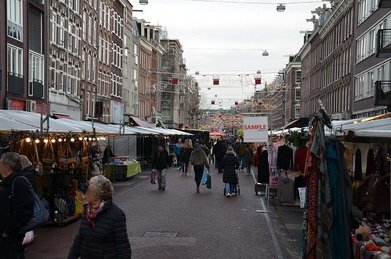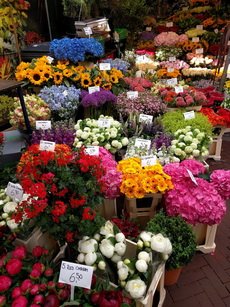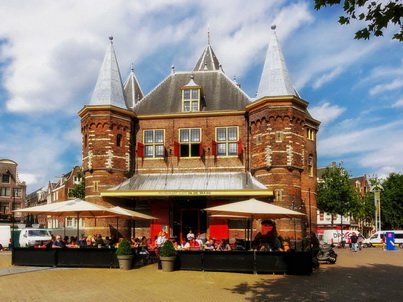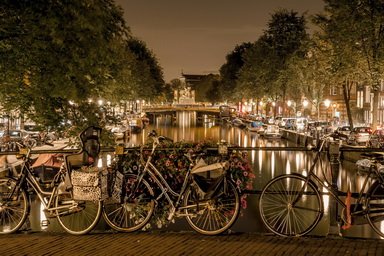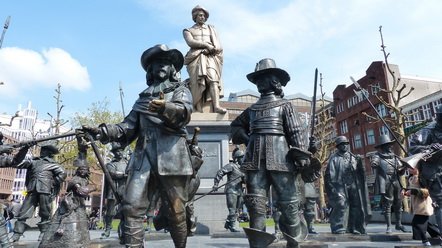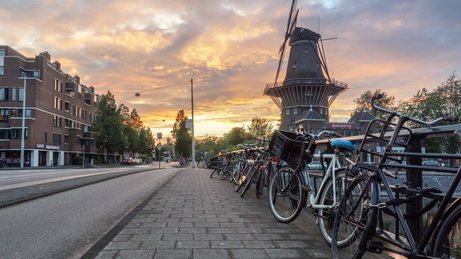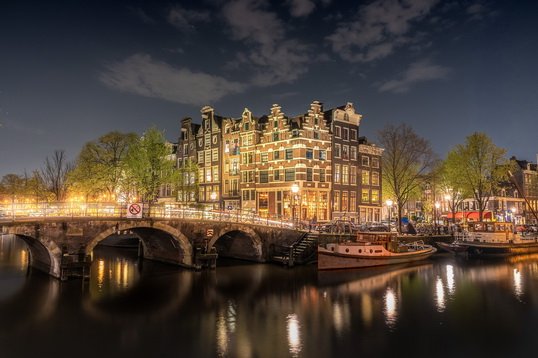Main attractions
View on the map
1 Central Railway Station
The main train station building is one of those things that you are bound to see in Amsterdam whether you want to or not. The majority of the tourist traffic naturally passes through it and it is just next to some other places of interest.
You may have a feeling of it being so like the Rijksmuseum and you will be right. Both were designed by the same architect P.J.H. Cuypers in neo-Renaissance, neo-Gothic styles of the end of the XIX century.
It is a piece of art because of numerous reasons. A.L. van Gendt (the second architect) and his friend had quite a problem in designing the right building and making it a reality. Amsterdam is a place of unstable ground, surrounded by water. And the construction literally happened on the shore of Lake IJ. Three islands had to be man-made and 8687 wooden piles put into the ground to stabilize everything. Even those precautions were not enough – the station collapsed a few times before it was finally finished. It was such a masterpiece that on the first day of the opening before the trains started to run, tourists visited it. They paid 0,25 Guelders for a ticket – after only 2 days, the station gained a few hundred thousand Guelders!
Since that time, it was refurbished many times and received a second building more to the north. They are both now covered by a huge cupola of steel. Streets grew with the station – carriages were replaced by first trams and cars and the surrounding area had to be changed. But the neogothic façade greets you today as it has been doing since the start. You can venture inside and among the modern additions find a golden gate of the Royal Waiting Room (on the East side). A space for the king and queen was big enough for a whole carriage with horses to fit in. The interior décor of the whole station is also worth mentioning – it was made by G. Sturm, a notable Dutch painter.
2 The Dam Square
It is a perfect example of the name revealing the story. The city, at its beginnings, grew on two banks of the river Amstel. At some point, the floods caused by the Zuidersee were so severe that a dam was created. It not only helped with the flooding but also joined the settlements. By this, people received their main square as well and it is regarded as such till this day.
Not far from 1270 – the year of the construction of the dam, the square started to grow rapidly. A fish market was added, which was quite convenient since the ship anchored just next to it. A weigh-house became an addition later, giving the place even more administrative power. Nearby canals were filled, and more buildings were created around it – augmenting its social and commercial status as well.
The church you will find here is the Nieuwe Kerk. The previous one was not sufficient for the growing population of Amsterdam. The site on the Dam Square was chosen for its growing importance and the central location. The building survived a few fires and was finally reconstructed in the gothic and renaissance styles of the XVII and XVIII centuries. You will have little, sacral experience inside since the place became a café/exhibit gallery. But it is still worth to venture inside, see stunning stained glass depicting historical events, the organs, the book, and postcard-store and the place of many royal weddings (since 1815 it was a National Church and by this the place of many royal and national events).
The huge structure just next to is the Town Hall and the Royal Palace in one. It is a definite must-see for those liking the rich decoration of the royal houses. Numerous chandeliers, marbles, high ceilings – it takes your breath away. The most notable things can be found in the grand hall – the maps of the world since Holland was one of the colonist empires and the figure of Atlas carrying the world on his shoulders.
The Palace is one of the four places still accessible to royalty, so it may be closed to the public if they are visiting. It is the symbol of the changing nation – being built in the Golden Ages of XVII century, taking the role of the city hall, housing Louis Bonaparte who deconstructed the weigh-house because it spoiled his views… finally becoming the royal house of the House of Orange in 1808 which is now sharing it with the public.
The Dam Square should be on your to-do-list just because of its historical importance, but not only… It is a great social place full of bars and restaurants. There is always something happening there, be it a simple performance or a festival. There are great department stores there, there is a huge building of Madame Tussaud Wax Museum… but you can always try to become a piece of art in the Museumphoto. It is also in the middle of the city, so it is close to everywhere, having tram links to any place you want to go. If only to get somewhere, you will probably cross it on your way.
Don’t forget about the spire of the National Monument (photo above). It was erected to commemorate the soldiers from the Second World War – if you come here on the 4th of May you will have some National Day Celebrations to enjoy.
3 De Wallen aka Red District
Somehow this particular part of the city became one of the most famous attractions in Amsterdam. You can imagine every European city having its own sex-street, but here it became a normal part of life, regulated by law even. Tourists love it for its openness to this “scandalous” subject and for the colors it flashes at them at night creating a magical place with its neons.
They can see many Belles dancing in the windows, covered in blue or red light depending on the desires of the passing crowds. They pass them at the street level, or they see them on the upper floors – fascinating and inviting. The thematic museums here come with some treats as well. The Sex Museum is quite historically informative and the Condomerie being both hilarious and amazing.
A long way had to pass before it happened. Prostitution was the normal part of every harbor city, sometimes being more open, sometimes hiding in the shadows and under cover of a massage parlor or a gambling house. In 1911 it was stated that pimping and brothels are not allowed, but there was no word on prostitution. It evolved, and now you can even go to the Prostitution Information Centre, whose goal is to protect both client and the worker… and to give you the most amazing tour of the district!
Sex and tolerance are not the only subjects which are no longer the taboo subject… De Wallen is also a place full of famous coffee shops and home to the Museum of Cannabis.
Surrounded by all these joyful subjects don’t forget that you are in one of the oldest parts of the city. The Oude Kerk is the living proof of that – it was erected in the XV century and is still there. Firstly made of wood, it then gained more gothic character and was still in use even after building the New Church on Dam Square. It is the final resting place of Frans Banning Cocq – the central character of the most famous painting in Amsterdam – The Night Watch.
4 Jordaan
The area has a turbulent past of being on the left side of the city’s defense system. A large system of ditches and patches was forming it – they transformed into the roads of today’s district. Amsterdam grew, and this part of the town became a good place to start the construction of some new houses. The defense system disappeared, some canals and ditches were filled, a multitude of houses concentrated around hofjes (inner courtyards) was formed. The area became popular among the working people of Amsterdam, although because of it and some difficult parts of history, it was also a place where riots broke.
Today Jordaan is completely transformed. At some point in the XX century, the newly reconstructed buildings started to attract artists. Today – it is the art area of Amsterdam, full of galleries, old craft displays above the shops, restaurants, bars, and shopping areas (9 street area is just next to it).
Here you can taste some Dutch cheese or visit a museum of the most famous flower of Holland – the tulip. It is also a place where Anne Frank was hiding during the Jewish persecutions of the II World War. You can visit the house-museum and relive the stories of her young, 13-year-old life, spend in hiding. The atrocities of war are a reminder as always, and the museum itself is one of the most visited places in Amsterdam.
After the Museum you can bow to Rembrandt in the Westerkerk (photo to the right). The artist died poor and was buried here as such. This meant that at some point his remains were removed to make way for new ones. But there is still a commemorative plaque inside and he is remembered here every year with a concert.
5 Museumplein
The Golden Age in Dutch history is a code word for a number of important happenings and discoveries. One of those is the era of the most famous painters such as Johannes Vermeer, Dirck Hals, Aert de Gelder, and many more. The most know by far, known for his colorful life story and brilliant works, is Rembrandt van Rijn.
Beautiful Amsterdam tenements, with pulleys on top, dormers, and ornated roofs are another part of it and make wandering around Amsterdam a fulfilling experience.
But returning to the subject – the artifacts of the Golden Age of paintings and some other parts of Dutch history can be seen in one place – no need to look for anything. Direct yourself to the outskirts of the canal ring to a place called Museumplein. You will find a green space there, with some benches to sit on, green grass to lie and sunbathe, a water pool that is turning into an ice ring in winter and… the most important of the city’s museums.
Rijksmuseum is the Louvre of Amsterdam. It must lay in the Bonaparte blood to love art since it was Louis Napoleon who ordered the creation of the museum. It has about 1 million artifacts but only 8000 are on display. Apart from the whole building that is a piece of the neo-arts, it is the house for the masters of the Dutch painting and more. You can admire the life of the Golden Age here – local navy, the life of the harbor city, everyday problems of the sellers, mothers looking for lice in the hair of their child, or even find the first stroopwafels on a display. The pearls are The Night Watch (Rembrandt), The Milkmaiden (Vermeer), The Skaters (Avercamp), or the Research Art Library.
If it is not enough, go to the adjacent Van Gogh Museum and have a look into the heart and mind of this famous artist. The building is a modern creation from the 60s of the previous century. It has a decent café inside if you are looking to have a quick caffeine shop. And the flowers and insight of Van Gogh is a pure pleasure to adore. No wonder that some pieces were being stolen only in 1991.
Apart from those, you will find there Stedelijk Museum of modern art, the Concert Hall, and the transportation hub. The “park” itself is a notable gathering spot once adorned by the I Amsterdam sign (until 2018). You can catch a breath there before going further or in between the Coster Diamonds or Heineken experiences. It is also just a tram ride/or a longer walk from Albertcuyp or the Vondelpark (the entrance is very close by, but the park itself is a huge place).
6 Begijnhof
Hofje is a Dutch name for a “courtyard” but they turned out to get a different function in this country. Not only there was a square surrounded by houses, but here it served some charitable purpose. There were normally some almhouses (beggar houses) there, or the houses were reserved for elderly people, who were provided care in this way.
The most famous hofje in Amsterdam is the Begijnhof. It was created by a group of religious women who dedicated their lives to prayer and charity. They were not nuns, although being a sort of a nun refuge was common in hofjes. They lived calmly and spread their mission from 1300 up till the 1970s. Today some single women live here. They have two churches inside and an area of peace and quiet. The place is accessible to the public through a narrow passage leading from Spui Square or the door at Gedempte Begijnensloot street.
The Amsterdam Museum is just next to it, so you can rest in the courtyard afterward.
7 Museum or tasting
Amsterdam is by far the place where you can find the biggest quantity of strange, amazing, and tiny museums in one place. It is both welcomed and surprising, when you enter, what is supposed to be a shop, only to find a hidden gem in a corner or downstairs.
A simple experience of tasting local cheese can turn out to be a very informative journey to the story of this treat – there is one in Jordaan close to Anne Frank’s House-Museum. The Tulip Museum is in the same district and it offers some insight into how this flower came to Amsterdam and what was the Tulip Mania of the XVII century.
Do not forget the House of Rembrandt – the city does not exist without its most famous, XVII century painter and townsman. He lived on Jodenbreestraat for two decades and later the place became a shrine to his name You will see their drawings, memories, some paintings, and get a glimpse of the artist’s daily life.
The Amsterdam Museum is another historical one – concentrating on the story of the city that grew in the most unfriendly environment.
Tasting is a theme here, and it would not be a full experience without something to drink. There are several distilleries in the city offering liqueurs or beers and sharing stories. Wynand Fockink (close to Oude Kerk) is one such place, but if you are looking for something more famous – try the Heineken experience. Brouwerij ’t IJ is a place not far from the city where you can get both beers and see the holland windmills (check the first photo of point 10). And if it is too far – try the Beer Temple in the city or the Beer Festival which concentrates around the Beurs van Berlage building.
And if it is not enough still – try learning about diamonds with Gassan or Royal Coster. Amsterdam is truly a place to let your senses guide you.
8 Markets and shopping
Shopping and food tasting in Amsterdam is a must-do. You literally cannot do one without the other. Just going to Museum-Tasting places is hard labor if you want to forbid yourself from buying anything.
The city has some wonderful department stores. They are both pieces of historical art and a place where you will find all the modern shops of all the kinds you would like. The Magna Plaza, just behind the Palace of the Dam Square is in a former post-office building. It is a mixture of neo-gothic and neo-renaissance architecture, lit inside with the sunroofs. The décor demands admiring – the polychromic bricks, domes and towers, and beautiful, numerous dormers of the roof. The Beehive Bijenhof sits on the square itself, offering both everyday life merchandise and souvenirs. The top floor has a cafeteria with some nice views over the city.
Amsterdam was part of the Hanseatic League, and this tradition is continued with passion. Kalvenstraat and Leidenstraat are other examples – this time for the clothes and shoe hunters of both medium and high marks. There is also a special shopping area called 9 Street (Hartenstraat, Huidenstraat) with a range of shops from fashion to bookstores. There are cafes, bargains, and treats for the true fashionistas.
You also cannot miss the traditional markets full of souvenirs, food, and anything else without a proper “name”. These are the ones to watch out for prices – some things can cost too much; others are just too beautiful not to buy even if they will empty the wallet. But there are bargains as well, always useful everyday things with Dutch accents, places to sample food or buy edible souvenirs. Waterplein Flea Market is for those looking for the pearl that needs some dusting. It is one of the oldest city-markets. Albertcuyp Market is a treat for food and small souvenir lovers as well for those wanting to find a winter hat adorned with tulips. And the Bloemenmarkt… the floating flower market is everything that Amsterdam once was, and even if you can’t buy anything there it is worth seeing.
9 Chinatown or the Neuwmarkt area
The city was growing in a few stages slowly adding central squares, churches, and some living quarters. The New Market was formed in 1614, after filling the canals around. Another trading area was formed, hence the name, and the former gate was turned into the weigh house. This is the most imposing building of the square today. It was higher once, but the level of the road was elevated. Today there is a café but once it housed the offices of numerous guilds. One of them was the painters and the surgeons and Rembrandt made his Anatomy Lesson here in 1632.
The square and the adjacent street – Zeedijk, are called Chinatown. Apart from them living here from the beginnings of the XX century, you will find a Buddhist temple, shops, and even some street names in Chinese. Needless to say – you have to come here for the tasty food, not only from China but from Thailand as well. You must try the zeedijk sandwiches from Slagerij (Butcher) Vet – the delicious meat and the famous sauce turns this simple dish into a completely different thing. The sauce is curry based, but it is all you know because the recipe is the family secret.
10 Relaxing in a park or a coffee shop
The story of cannabis in Amsterdam starts in 1953 when the Opium Act restricted the usage. A few years later the city made an amendment to it, making a distinction between it and hard drugs. A policy of tolerance started in these years and it is embedded in the mind of the Holland people. The first coffee shop – The Bulldog was a bullseye and soon many more followed. Rules were made and now you can legally buy cannabis in Amsterdam or enjoy the relaxed-reggae-like atmosphere of the coffee-shops. Whether you want to smoke a joint they sell or you just want to drink a coffee in the mist made by all the smokers… the reasons are different, but it is definitely worth to see such a place.
Another place to relax in the green space provided by the numerous parks of Amsterdam. Contrary to the feeling of an organized landscape, here you have a feeling of the wildlife around you. The Vondelpark is a close and notable example. The entrance is just next to the Museumplein. Its story starts in the middle of the XIX century and for a while, it was a private place and you had to buy tickets to enter. Much has changed since then, and today it is a place holding a lot of dance and music venues. In the meantime, everyone can rest in the shadow of the trees, looking at the lakes and hiding from their everyday problems.
In the East part of town, there also is the Hortus Botanicus. Nothing can go wrong by going to the botanical garden and the collection of almost 400 years will not disappoint. The Garden is just next to the Wortheimpark and the zoo, so you have some options. ARTIS is one of the oldest zoological parks in Europe, being founded in 1838. You have all your favorites there, and Aviarium and a one-of-a-kind – the Microbe Area, where you will learn more about this tiny world around us. Natura Artis Magistra is the longer name of the zoo, so remember what you can learn from nature, and let yourself enjoy some other parts of Amsterdam.
11 Walking or riding along the canals of Amsterdam
You cannot miss your walk around the canals of Amsterdam. They come in many shapes and sizes, lovely tenements, or adorable bridges to stand on and admire the area. You can try a boat cruise around them, rent a bike, or just stroll around.
Find your perfect place to sit or drink a coffee, observe the sunrays smiling at you through the leaves of the surrounding trees and simply – enjoy. They are breath-taking at any time of the day, covered in a mist of the morning or the soft, warm glow of the evening. They wink at you with the red light of De Wallen district or are a perfect background for a photo of Amsterdam bikes. Try one of the many brown cafes. Their name comes from the brown color of wood and cigarette smoke. Today the smoke is just a memory, but they are as welcoming as they once were, and they often have some tables outdoors.
Walking around you can find some interesting sites there. The Weeping Tower, where the wives once said goodbye to their husbands working at sea, stands at the corner of Geldersekade and Oudezjids Kolk (not far from the Central Station). The Home at the 3 canals stands at the oldest part of the waterway, going back to the XIV century. The Magere Brug on the other hand is a piece of old engineering wonder – it lifts in order to let the river traffic pass. And the Rembrandt Monument stands at the corner of the canals and river Amstel. It is the very place where shooting exercises once happened. Once there was a tavern close by, where the Night Watch hand for a while. Today you can see the masterpiece but in another form.
12 A stone throw away…
When we come to Amsterdam we also arrive in Holland. Several things come to mind thinking about it and the number of souvenirs around you is not the only reason. Tulips, windmills, and wooden shoes are the first that come to mind. And coming to this city gives you a great opportunity to see it all. If you happen to stay in Amsterdam for longer – why not try to see some places away from the city center.
Finding true windmill can be the easiest task. For a while they were everywhere – they were used to drain the fields, to provide energy for sawmills and grain crushers. In a place of so much wind – they were an enormous help and today Holland still has around 1000 of them. The ones closest to the city center are the Otter Windmill – still operational, so it will be difficult to visit it. But the second one is a part of a brewery now and you can “kill two birds with one stone” – this is the Brouwerij’t IJ/ Molen de Gooyer. A former flour mill sits proudly on top of the old bathhouse buildings. Since the 80s, there has been a brewery doing its fine job in creating delicious Dutch beer. Today you can come inside, have a quick tour where they will explain how the production works, and then relax in the shadow of the wings, eating a snack and sipping the golden drink.
A train ride from Amsterdam you will find de Adrian Mill in Haarlem which is perfect if you would like to have a 45-minute tour inside a mill. Zaanse Schans, on the other hand, gives you an opportunity to join in some cheese tasting. It is also a historical area full of wooden houses from the XVIII and XIX centuries. There is more than one mill there and on a sunny day, it is a perfect place to run from the business of capital. You can also have an opportunity to stumble upon some demonstration of wooden shoe making or liqueur distilling.
Tulip fields are the furthest away and you need to come in a specific period. They bloom already in March, but the best time comes in April (max till mid-April). Some fields are there mostly for bulb production, not flower cutting. It may be a shock that they are cut in their prime. The best way to visit is to take a train/bus to Keukenhof/Bollenstreek. It is quite a big region around Lisse – come in good weather, rent a bike, and enjoy your day around tulips, daffodils, and hyacinths. There is also a boat tour to get, starting from Keukenhof and running among the flower fields or walk in their Spring Garden. You can also try to come to the Flower Parade there, which is held on the 17th of April.
Top 10 list
- Wandering around the canals
- De Wallen at night
- Checking out the strange museums – Sex Museum or Cannabis Museum
- Albertcuyp
- Tastings – cheese, stroopwaffeln and liquers
- Night Watch – Westerkerk, Rembrandt Monument and Museum, THE painting
- Anne Frank Museum
- NEMO Museum viewing point
- Begijnhof
- Nieuwmarkt ambiance and food



